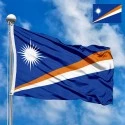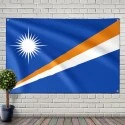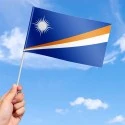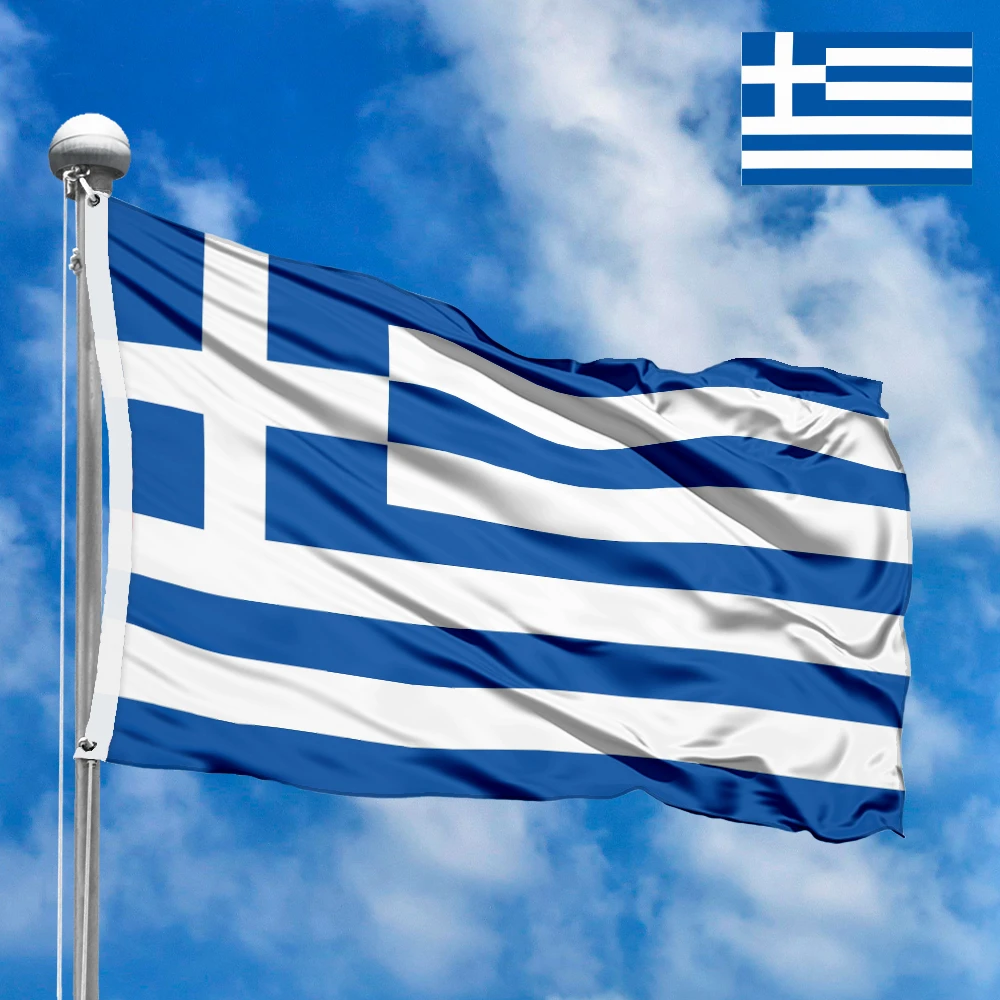The flag of the Marshall Islands is a vibrant and deeply symbolic representation of the nation's geography, history, and the aspirations of its people. Adopted on May 1, 1979, the flag’s design is a powerful visual narrative, celebrating the country's emergence as a self-governing republic and its unique place in the vast Pacific Ocean.
Design and Symbolism
The flag features a deep blue field with two diagonal stripes: an orange stripe above a white stripe, both rising from the lower hoist-side corner to the upper fly-side corner. In the upper hoist-side corner, a large white star with 24 points is placed.
-
The Blue Field: The background of the flag is a deep blue, which represents the Pacific Ocean. This color symbolizes the ocean's central role in the lives of the Marshallese people, their identity as islanders, and the immense sea that connects their many atolls. The ocean is not a barrier but a path, a source of sustenance, and a defining element of their culture.
-
The Orange Stripe: This diagonal stripe symbolizes the two primary island chains of the Marshall Islands: the Ralik Chain and the Ratak Chain. The orange color specifically represents the sunrise (Ratak Chain), courage, and the vibrant life that begins each day. It also signifies the nation's strength and the bravery of its people in achieving self-governance.
-
The White Stripe: Running parallel to the orange stripe, the white stripe symbolizes the sunset (Ralik Chain), peace, and tranquility. It signifies the peaceful future and the nation's enduring spirit. Together, the two stripes also represent the two main island chains as they emerge from the ocean. The stripes start narrow and widen as they cross the flag, symbolizing the growth and prosperity of the nation.
-
The 24-Pointed Star: The prominent white star in the upper hoist corner represents the 24 electoral districts of the Marshall Islands, highlighting the democratic unity of the nation. The four longer points of the star represent the four most populated islands: Majuro, Kwajalein, Wotje, and Jaluit, and are also a subtle nod to the Christian cross, reflecting the strong Christian faith of the populace. The white color of the star signifies light, hope, and the brightness of the future.
History and Adoption
Before 1979, the Marshall Islands were part of the Trust Territory of the Pacific Islands, administered by the United States. As the nation moved toward independence, a new flag was needed to replace the territory's flag. A national design competition was held, and the winning entry was created by Emlain Kabua, the first First Lady of the Marshall Islands. Her design was chosen for its rich symbolism and its clear connection to the nation’s heritage.
The flag was officially adopted on May 1, 1979, the date when the country's constitution came into effect and the Republic of the Marshall Islands was formed. The design beautifully captures the essence of the nation: its geography, its culture, and its aspirations for a peaceful and prosperous future. The fact that the flag was designed by the First Lady gives it a special, personal significance for the Marshallese people.
Flag Size and Proportions
The official ratio of the flag of the Marshall Islands is 10:19 (height to width). The diagonal stripes run from the lower-left to the upper-right corner. The large star in the canton has specific dimensions and placement to ensure consistency and a balanced aesthetic. The stripes' width increases from a starting point at the corner, symbolizing growth.
The Country, Region, and Meaning for Residents
The Republic of the Marshall Islands is a nation of 29 coral atolls and five isolated islands, located in the Micronesia region of the Pacific Ocean. The country's unique geography as a collection of low-lying atolls makes it particularly vulnerable to climate change, a challenge that is at the forefront of the nation's consciousness.
For the Marshallese people, the flag is not just a national symbol but a representation of their home, their identity, and their resilience. The blue field speaks of their life with and on the ocean, the stripes of the two island chains and their cultural unity, and the star of their democratic future. The flag serves as a reminder of their successful journey to sovereignty and their collective identity as a unified people facing the future together.
Interesting Facts
-
The two diagonal stripes, symbolizing the two island chains, are a unique feature among national flags, representing a physical and cultural division that is united under one nation.
-
The 24-pointed star is one of the more intricate and detailed stars on a national flag, with the four longer points representing the most important atolls.
-
The flag's designer, Emlain Kabua, was married to Amata Kabua, the first president of the Marshall Islands.
The flag of the Marshall Islands is a powerful and meaningful emblem, a testament to the nation’s enduring spirit, its cultural richness, and its profound connection to the Pacific Ocean.
In the demonstration images, full-size flags are shown with proportions of 2:3, and hand-held flags with proportions of 1:2.









 Waving flag
Waving flag
 Sizes:
Sizes:
 Round flag
Round flag
 Sizes:
Sizes:
 Rectangular flag 2:3
Rectangular flag 2:3
 Sizes:
Sizes: